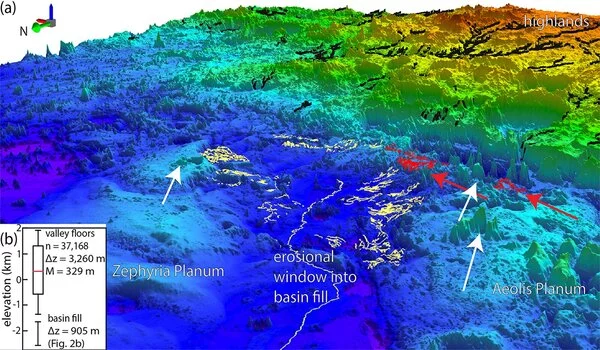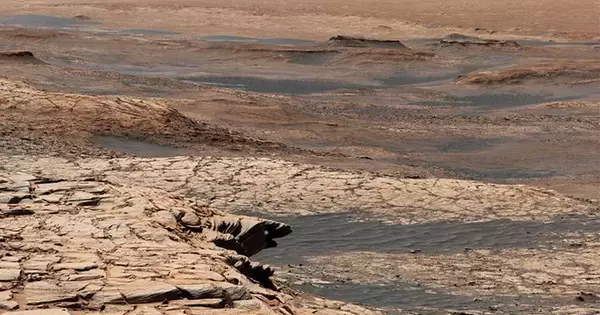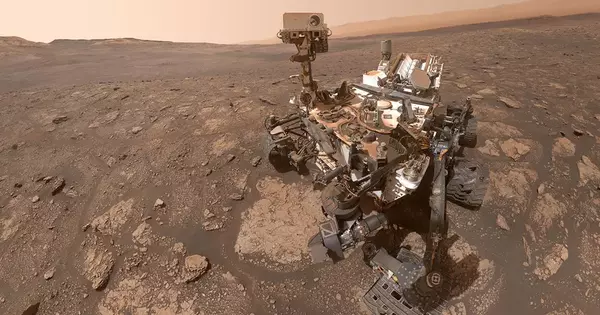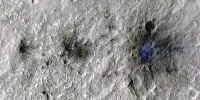Almost all of the water on Mars today exists as ice, though some exists as vapor in the atmosphere. What was previously thought to be low-volume liquid brines in shallow Martian soil, also known as recurrent slope lineae, may actually be grains of flowing sand and dust slipping downhill to form dark streaks. The north polar ice cap is the only place where water ice can be seen on the surface.
A new set of topography maps released recently provides new evidence for an ancient northern ocean on Mars. The maps provide the most compelling evidence yet that the planet once experienced sea-level rise consistent with a long period of warm and wet weather, rather than the harsh, frozen landscape that exists today.
“One of the most important points here is that the presence of an ocean of this size implies a higher potential for life,” said Benjamin Cardenas, assistant professor of geosciences at Penn State and lead author on the study published recently in the Journal of Geophysical Research: Planets. “It also reveals information about the ancient climate and its evolution. Based on these findings, we know there had to be a time when the temperature was high enough and the atmosphere was dense enough to support this much liquid water at once.”
Cardenas explained that there has long been debate in the scientific community about whether Mars had an ocean in its low-elevation northern hemisphere. The research team was able to show definitive evidence of a roughly 3.5-billion-year-old shoreline with significant sedimentary accumulation, at least 900 meters thick, that covered hundreds of thousands of square kilometers using topography data.
The rocks in Aeolis Dorsa capture some fascinating information about what the ocean was like. It was dynamic. The sea level rose significantly. Rocks were being deposited along its basins at a fast rate. There was a lot of change happening here.
Benjamin Cardenas
“The big, novel thing that we did in this paper thought about Mars in terms of its stratigraphy and its sedimentary record,” Cardenas said. “On Earth, we chart the history of waterways by looking at sediment that is deposited over time. We call that stratigraphy, the idea that water transports sediment and you can measure the changes on Earth by understanding the way that sediment piles up. That’s what we’ve done here – but it’s Mars.”
The team used software developed by the United States Geological Survey to map data from the National Aeronautics and Space Administration (NASA) and the Mars Orbiter Laser Altimeter. They discovered over 6,500 kilometers of fluvial ridges and grouped them into 20 systems to show that the ridges are likely eroded river deltas or submarine-channel belts, the remnants of an ancient Martian shoreline.
Elements of rock formations, such as ridge-system thicknesses, elevations, locations and possible sedimentary flow directions helped the team understand the evolution of the region’s paleogeography. The area that was once ocean is now known as Aeolis Dorsa and contains the densest collection of fluvial ridges on the planet, Cardenas explained.
“The rocks in Aeolis Dorsa capture some fascinating information about what the ocean was like,” he said. “It was dynamic. The sea level rose significantly. Rocks were being deposited along its basins at a fast rate. There was a lot of change happening here.”

Cardenas explained that ancient sedimentary basins on Earth contain stratigraphic records of evolving climate and life. If scientists want to find evidence of life on Mars, they should start with an ocean the size of the one that once covered Aeolis Dorsa.
“One of the primary goals of the Mars Curiosity rover missions is to look for signs of life,” Cardenas explained. “It’s always been on the lookout for water, for signs of habitable life.” This is the largest yet. It’s a massive body of water fed by sediments carried by rivers from the highlands. If ancient Mars had tides, they would have been here, gently bringing in and out water. This is exactly the type of place where ancient Martian life could have evolved.”
Cardenas and his colleagues have discovered additional ancient waterways on Mars. According to an upcoming study in the Journal of Sedimentary Research, various outcrops visited by the Curiosity rover were most likely sedimentary strata from ancient river bars. Another paper published in Nature Geoscience applies an acoustic imaging technique used to view stratigraphy beneath the seafloor of the Gulf of Mexico to a model of Mars-like basin erosion. The researchers determined that the fluvial ridges found all over Mars are most likely ancient river deposits eroded from large basins similar to Aeolis Dorsa.
“The stratigraphy we’re interpreting here is very similar to stratigraphy on Earth,” Cardenas explained. “Yes, discovering records of large waterways on Mars sounds like a big claim, but in reality, this is relatively mundane stratigraphy. Once you recognize it for what it is, it’s textbook geology. The interesting part is that it’s on Mars.”
















